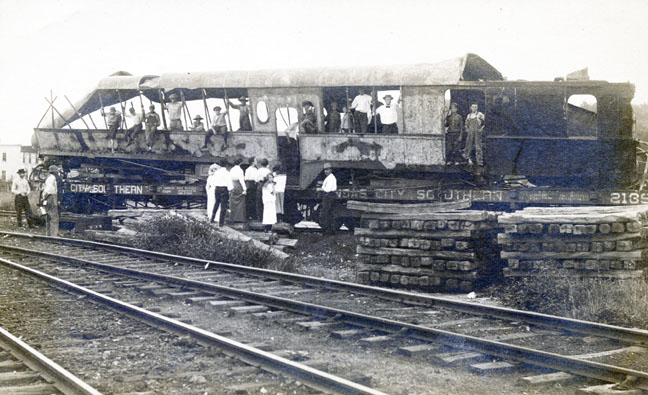 This week is the 100th anniversary of something horrible … and chances are you’ve never heard of it. It made national news headlines in its day, and then suddenly disappeared from sight. It’s particularly astonishing to me that as a history buff from the moment I learned to read, I only found out about it recently. So sit back and learn the sad tale of a terrible tragedy.
This week is the 100th anniversary of something horrible … and chances are you’ve never heard of it. It made national news headlines in its day, and then suddenly disappeared from sight. It’s particularly astonishing to me that as a history buff from the moment I learned to read, I only found out about it recently. So sit back and learn the sad tale of a terrible tragedy.
First, let’s set the scene. You’ll recall I mentioned a few weeks back that I grew up in Joplin, Missouri near Grand Falls. This lovely waterfall is on Shoal Creek, which meanders through the foothills of the Ozark Mountains.
About 10 or 12 miles to the south is a little community called Tipton Ford, named for the spot where folks crossed the creek in the 19th Century.
Fast forward to the late afternoon of Wednesday, August 5, 1914, as a typically hot summer day in the country’s midsection was winding down. Even a century ago, people did a lot of commuting. Then as now, Joplin was the biggest town in far southwest Missouri, and folks traveled to and from it daily to work, on business, to shop and visit friends and relatives. Which is where the Missouri and North Arkansas Railroad enters the story.
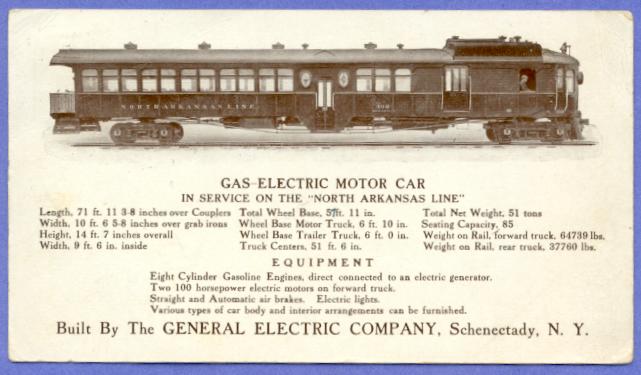 The railway provided service between Joplin and northwest Arkansas on what was called a Gas-Electric Motor Car (similar to the one shown here). Think of a street car or a trolley, only bigger, the size of a full passenger car. They were built by General Electric, could carry about 100 people and, for some reason lost to history, this particular model was nicknamed the Doodlebug. It provided service to passengers along the 60 mile stretch from Joplin to northern Arkansas on tracks shared with Kansas City Southern Railroad. Which was how the trouble started.
The railway provided service between Joplin and northwest Arkansas on what was called a Gas-Electric Motor Car (similar to the one shown here). Think of a street car or a trolley, only bigger, the size of a full passenger car. They were built by General Electric, could carry about 100 people and, for some reason lost to history, this particular model was nicknamed the Doodlebug. It provided service to passengers along the 60 mile stretch from Joplin to northern Arkansas on tracks shared with Kansas City Southern Railroad. Which was how the trouble started.
A Motor Car filled with passengers left Joplin as scheduled early that Wednesday evening heading south … directly into the path of a Kansas City Southern passenger train heading north. Among its estimated 80 passengers were members of nearby Neosho, Missouri’s African-American community, who were returning home after attending Emancipation Day ceremonies in Joplin.
[Note: Some historical sources refer to the KCS train as a freight train. But the Missouri Public Service Commission’s official report says it was actually a passenger train.)
 The trains met head-on near Tipton Ford. The Passenger train ripped open the Motor Car’s gasoline tank, spewing fuel and igniting a massive fireball. The blast was so strong, it blew some passengers out the windows and onto the ground. They were the lucky ones; dozens of others were trapped under blazing wreckage. Injured people actually begged to be shot and killed as they slowly burned to death.
The trains met head-on near Tipton Ford. The Passenger train ripped open the Motor Car’s gasoline tank, spewing fuel and igniting a massive fireball. The blast was so strong, it blew some passengers out the windows and onto the ground. They were the lucky ones; dozens of others were trapped under blazing wreckage. Injured people actually begged to be shot and killed as they slowly burned to death.
Someone ran to the nearest house with a telephone, and soon an emergency train filled with doctors, nurses and medical supplies rushed south from Joplin. When they arrived, the scene must have looked like Hell on Earth.
The flames were eventually put out. The best guess had the death toll at 43 – 38 passengers and five crew. But the bodies were so badly burned, the exact count may never be known. It ranks among the top 25 deadliest train crashes in American history.
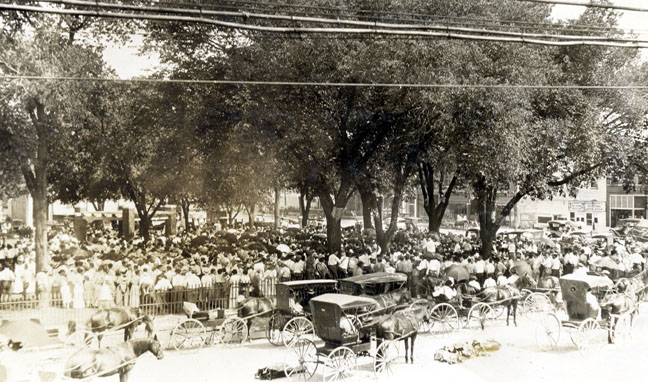 With the track clear to the south, survivors and victims alike were rushed to Neosho. A few days later, an estimated 5,000 people flooded the town square for a memorial service. (Note the large number of horse and buggies still used in 1914 in the photo.)
With the track clear to the south, survivors and victims alike were rushed to Neosho. A few days later, an estimated 5,000 people flooded the town square for a memorial service. (Note the large number of horse and buggies still used in 1914 in the photo.)
So, how did the deadly mistake that placed two trains on the same track happen? Even 100 years later, nobody knows for sure. An investigation by Missouri state officials found an order had been issued for the Motor Car to pull onto a sideline and let the passenger train pass, but the crew never received it. It’s unclear how the mix-up happened, but it’s worth noting the depot clerk who said he delivered the order had previously been fired from an earlier railroad job for failing to deliver a similar order.
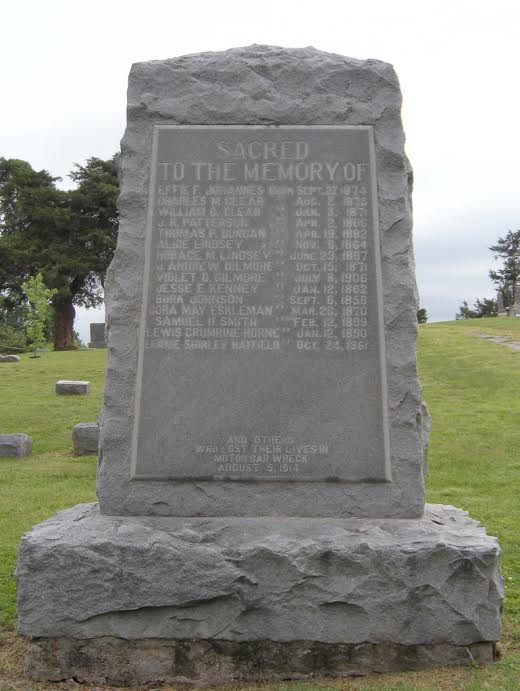 Many of the victims were buried in Neosho’s I.O.O.F. Cemetery, and a marker was eventually erected to their memory. For countless decades, people passed by without stopping to read its sad inscription.
Many of the victims were buried in Neosho’s I.O.O.F. Cemetery, and a marker was eventually erected to their memory. For countless decades, people passed by without stopping to read its sad inscription.
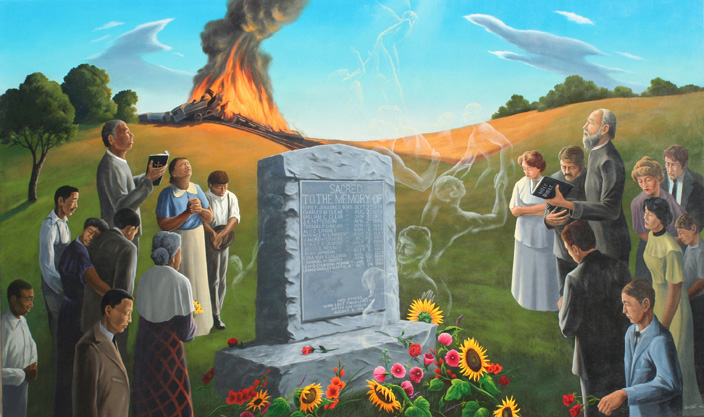 A few years ago, a lovely mural commemorating the tragedy was painted by Anthony Benton Gude, grandson of famous Missouri muralist Thomas Hart Benton. It hangs today in Neosho’s United Methodist Church.
A few years ago, a lovely mural commemorating the tragedy was painted by Anthony Benton Gude, grandson of famous Missouri muralist Thomas Hart Benton. It hangs today in Neosho’s United Methodist Church.
As I said earlier, the accident was national news. The New York Times and many other leading newspapers covered it. But almost as soon as it happened, the story was swept off the front page. A lot was happening in the summer of 1914 – such as the start of World War I. Over the decades, the Tipton Ford tragedy was quietly lost in the mist of time.
Thankfully, more and more people are becoming aware of the accident. Several memorial services marking the crash’s centennial will be held in southwest Missouri this week. And a stone marker is being erected at the site of the disaster, so 21st Century children can learn just how fragile life is, and how suddenly and unexpectedly it can be taken away.
(Did you find this enjoyable or helpful? Please share it with your friends and help a rookie author become established. Sign up for email alerts for future blog posts, too. Thank you!)

This was a great article. I’m glad that more people are learning of this very sad incident in our regional history. My Grandpa Russell spoke of taking day trips with his father to Neosho on Saturdays to buy farm supplies, groceries, etc. It would take them all day to make a round trip. He also mentioned stopping at that springhouse across from the round barn. I like to imagine how the countryside looked back in those days. Thank you for sharing this with us!
You’re welcome; thank you for taking time to read it, too. See you next Sunday.
It’s good to fill in this very important blank in history. As those of us in the news business know, organizations sometimes victimize themselves with a sort of tunnel vision; a big story happens and the gaggle of reporters, whether in newsrooms or on location, all lumber over to the big newer story, leaving complaints in their wake. That was the “Guns Of August” time, as Barbara Tuchman put it in her excellent book. Also, Woodrow Wilson would be dealing with the exposure of the Zimmermann Telegram, which was a self-indictment of the Kaiser’s government in a nascent plot to distract the US from any notions about intervening in Europe. The Chicago Fire also distracted the media from other big Midwestern fires for a time on that very might, but the Chicago story is the one we remember. It’s good to remind us all of this terrible event, Mark. Thanks for posting.
Good stuff. Thanks, DG!
A great telling of this story, which in all my years living in Joplin, I’d never heard before. Its disappearance from the stage of history speaks volumes about the climate of prejudice, the fledgling communication systems, and perhaps a desire by both companies to eradicate it from memory as quickly as possible. Thank you, Mark!
You’re most welcome, Kendra! I only heard about it recently myself and was stunned. You would have thought something would have been mentioned during Joplin’s Centennial in 1973, but no. By the way, I post a new story on my blog every Sunday … please visit again.
A truly sobering story, that I’d never heard before. Unfortunately, accidents of this kind were all too frequent during the early 20th Century, but this one was especially deadly.
I grew up by Cox Spring. I heard about this a few years ago. My dad’s family lived about a mile from there
Thanks for sharing, and for reading, Susan. I post a new blog entry every Sunday; please come back again!
As a child my great grandparents told of the crash at Tipton Ford. During the 60’s and 70’s we went to eat chicken at the Famos Tipton Ford Restuarant.
Thanks for sharing, Connie. I post a new blog entry every Sunday. Please visit again!
Does anyone know the exact location of the collision??
John: I’ve heard it was near Under the Cliff. Thanks for reading this post. I usually put up a new post on Sundays each week; please visit again. -J. Mark
IT was about 3/4 to 1 mile south of Under Cliff.
Thanks for commenting, Iletha.
I grew up in Neosho and I remember hearing about this years ago, but I had forgotten about it. Thanks for the very well done story!
Thanks for your comment, Terri. I appreciate it. By the way, I post a new blog update every Sunday; please visit jmarkpowell.com again!
This happened south of Under Cliff – towards Neosho. My grandmother was 15 and lived across from the round barn . She said everyone rushed to help , but heartbreaking to see and not be able to do much to help . Most of the people were from Neosho . She told me this story every Aug. 5th , with tears in her eyes.
Thanks for sharing her story, Jeannie
The KCS train was a passenger train; not a freight train.
http://specialcollection.dotlibrary.dot.gov/Document?db=DOT-RAILROAD&query=(select+205)
Indeed, it was, Karl. I had, unfortunately, relied on unreliable sources. The column has been updated
Loved reading this, had no idea. Used to go to Tipton Ford for fried chicken. Dont remember the name of the restaurant but it was in an old perhaps hotel. This would’ve been 50 years ago.
Glad you enjoyed it, Christine.
I remember hearing the story some years ago. Sooo tragic. 🙁 Thank you for keeping the early history alive. Both my parents’ families were early pioneers to Joplin area. I wish the old round barn area could have been saved. Many people have used it as a landmark! I grew up in the Joplin area ( JHS 1960). I’m looking forward to reading more of your articles!! 🙂 🙂
Thanks Stephanie. I miss the Round Barn, too. It was so pretty and so unique. It’s a shame it couldn’t have been saved.
Thanks looking forward to reading your blog on Sundays.
You made my day, Joanie! Thanks for your kind words.
Loved reading this story. I was born and raised in a small town called Granby, Mo. Both my dad and grandpa worked on the Frisco Railroad. But I never heard this story. Thanks for righting it.
Glad you enjoyed it, Charlotte. Being raised in southwest Missouri, I’ve been to Granby many times.
I certainly enjoyed reading your account of this terrible accident. It caught me a bit off guard when I first read it because the dates didn’t match with the train wreck that I had heard about all of my life. This sent me to my family records of the train wreck that involved my grandfather, Arthur M.C. Herd and his two brothers, Fred and John Herd. They were on the Kansas City Southern rail car headed for Anderson, MO to be with their dying father when the boiler blew up and the train wrecked (Sunday, February 1, 1914 – “Webb City Register”). This accident occurred shortly before January 29, 2014 because my grandfather went on to Anderson and was with his father, James Bird Herd, before he died. My grandfather’s brothers were injured and taken to St. John’s Hospital in Joplin, MO at the time of their father’s death. Keep up the good work. Growing up in Joplin, it is wonderful to hear and read the old and new stories about our area.
Thanks for reading it, Jeanne.
I learned about this while working on my family history. Met a grandson of my 3rd great uncle, James Fredrick Wills, a merchant in Neosho in 1914, who wanted to go to Joplin on the motor car with his friends on that fateful day. Something happened and he wasn’t able to go. His friends all died in the accident.
Thanks for writing, Julie. Thanks also for sharing your family’s connection to the tragedy; I enjoyed learning about it.
Love these small town snippets of history. Take a look at Haileyville, OK. Read a story last year, Nov, 2015, on a cork board at McAlester library wrote by a man who was trying to remind people of it’s coal mining history. More to it but I don’t recall all now. Maybe a future story for you. Thank you & keep net writing!
Thanks for your kind words, Terri. Glad you enjoyed it. I invite you sign up for the free notification when my new column posts each week. Please join us! And thanks again for reading.
Interesting story. I worked in Joplin for the Frisco railroad but had never heard this story, thanks.
Thanks for your kind words, Ron. Glad you enjoyed it. When I was young I was passionately in love with railroading; but life had a different career path for me. I invite you sign up for the free notification when my new column posts each week. Please join us! And thanks again for reading.
Thanks for sharing this interesting story. I have an avid hunger for anything in history related to our state and teach a High School course in Missouri History. I had never heard of this tragedy, seems like the only railroad tragedy you ever hear of was the 1855 Gasconade River disaster that had a delegation of dignitaries aboard. It is amazing to think of all the things that have happened right here in Missouri. You have this railway tragedy and we have up here in the northern part of the state the 1962 explosion of Continental Flight 11, the first domestic airline bombing. The FBI sent the Kansas City agent here to investigate and he would later become famous at Deep Throat in the Watergate scandal.
Thanks again for this bit of 1914 history!
Thanks for your kind words, Dan. Glad you enjoyed it. I share your passion for Missouri history. The Gasconade Bridge collapse was such a horrible tragedy, wasn’t it? Did you see the news story a few years back where divers think they’ve found the locomotive’s boiler? Anyway, I invite you sign up for the free notification when my new column posts each week. Please join us! And thanks again for reading.
I really enjoyed reading this. I never knew about the accident and I have lived around here my whole life.
Thanks for your kind words, Delores. Glad you enjoyed it. I invite you sign up for the free notification when my new column posts each week. Please join us! And thanks again for reading.
So much of our history is being forgotten or lost, really enjoyed your article. Thanks
Thanks for your kind words, Wilson. Glad you enjoyed it. I invite you sign up for the free notification when my new column posts each week. Please join us! And thanks again for reading.
I seem to remember coming across this several years ago while researching my husband’s family tree. They are black and part of his family was from Neosho area. I remember wondering if any of his relatives were hurt or killed. Don’t think I followed through with that though. Such a sad story. Thank you for “digging it up.” I also remember my grandmother, who was born in 1920, talking about riding something like this from Independence KS to other area towns, maybe even to Joplin. I think she called it the interurban. Wish we had something like that now!
WOW! I’ve lived in this town, all 56 years of my life, and never once, have I heard of this sad and horrific tragedy. Thank you so much for taking the time to research, and share, this life changing moment, of earlier times of our little town’s . I love my home town, and love to learn all I can about it.
Glad you enjoyed it, Lori.
I read James Fair’s history of the M&NA, so I have known of the Tipton Ford disaster for many years. According to Edmond Keilty in his book Doodlebug Country, the surviving M&NA gas-electric cars ended up on Muskogee Lines in Oklahoma. These would have been cars 102 and the second 103. The original 103 was the car destroyed in 1914. Every few years I think about the Tipton Ford Disaster because I am a rail fan with interests in Midwestern carriers and gas-electric rail cars. It is a very sad story.
Thanks for sharing.
I did enjoy your story and history. I was wondering if you knew how to find the names that were killed?
I am looking for my great grandparents that were killed on a train. I was told that He worked on the train and she was a passenger. Their last name was Huffman.
Thanks for your kind words, June. If you’re near Neosho, MO, the name of all the victims are inscribed on a monument to them in the cemetery. Also, you may want to check with the Neosho Public Library. They probably have a list. Good luck in your search!
Tragic. Also one of the reasons the distillate [pre-diesel] engine was developed for motor car use in the mid-1920’s. Distillate fuel was less apt to catch fire in a crash, as it would burn but generally not explode. Unfortunately this was not the only time a “gas car” caught fire with tragic results.
Thanks for sharing, Carl.
I started reading about this and thought it was about the Doodlebug Disaster that happened in Cuyahoga Falls, Ohio on July 31, 1940. Remarkably similar story. The Doodlebug was travelling from Hudson Ohio to Akron Ohio and failed to take a siding in Silver Lake to allow a freight train to pass. Needless to say the crash was horrific. Freight train telescoped into the Doodlebug, set the gasoline on fire. 41 people died. Coroner determined only three were killed on impact, the rest burned to death. There were only three survivors.
Edit my comments. Should be nine were killed on impact.